
The Importance of Choosing Pet-Safe Plants for Your Home
Are you a pet owner who loves bringing nature into your home but worries about the safety of your furry friends? Look no further! We have the perfect solution for your- pet-friendly plants. These green companions not only add life and beauty to your living space, but they are also entirely safe for your beloved cats and dogs.
The benefits of having pet-friendly indoor plants are two-fold. Not only do they improve the air quality in your home by removing toxins and releasing oxygen, but they also provide stimulation for your pets. Cats love to explore different textures and heights, while dogs enjoy sniffing and investigating new scents. With pet-friendly plants, you can give them a safe environment to satisfy their natural instincts.
By incorporating pet-friendly indoor air purifying plants into your living space, you can create a harmonious environment where both you and your pets can thrive together. Say goodbye to worrying about potential plant poisoning incidents or damage caused by curious paws; these specially chosen botanicals will ensure peace of mind while enhancing the overall aesthetic of your home. So why wait? Start transforming your home into a pet-friendly paradise today and enjoy the benefits of a greener, safer, and happier living space for both you and your furry friends.
Here are the 12 Indoor plants for your baby cat & dogs to bring them home.
- Spider Plant
- Boston Fern
- Areca Palm
- Money Tree
- Calathea
- Friendship Plant
- Bamboo Palm
- Watermelon Peperomia
- CalatheaOrbifolia
- Ponytail Palm
- Succulents
- African Violet
1. Spider Plant (Chlorophytum Comosum)
The spider plant, scientifically known as Chlorophytum comosum, is a popular choice for both plant enthusiasts and pet owners. Its unique appearance and low maintenance requirements make it an ideal addition to any indoor space.
One of the key benefits of the spider plant is its pet-friendly nature. Many houseplants can be toxic to cats and dogs, but the spider plant is entirely safe for our furry friends. This makes it an excellent option for those who want to bring some greenery into their homes without worrying about the safety of their pets.
In addition to being pet-safe, the spider plant also offers air-purifying properties. Like other plants, it takes in carbon dioxide and releases oxygen through photosynthesis. But what sets it apart is its ability to remove harmful toxins from the air, such as formaldehyde and xylene. This makes it an excellent choice for improving indoor air quality.
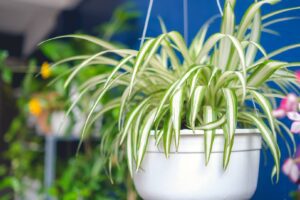
Instructions for use:
- Spider plants prefer temperatures between 60-75°F (15-24°C).
- Avoid fertilizing during the winter months.
- Avoid direct sunlight, as it can scorch the leaves.
- Inspect your plant regularly for any signs of infestation and take appropriate measures if needed.
2. Boston Fern (Nephrolepis Exaltata)
Boston fern (Nephrolepis exaltata) is not only a beautiful addition to your home decor but also a pet-friendly plant, making it an excellent choice for households with cats and dogs. One of the key advantages of the Boston fern is its non-toxic nature. This means that if your curious cat or playful dog decides to take a nibble or accidentally comes into contact with the plant, there is no need to worry about any harmful effects.
Additionally, the Boston fern can help improve air quality, benefiting both humans and pets alike. Like other plants, it releases oxygen and absorbs carbon dioxide, contributing to a healthier indoor environment.
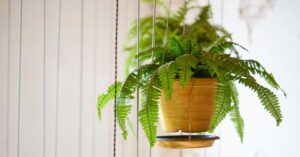
Instructions for use:
- Prefer moderate temperatures between 60-75°F (15-24°C).
- Prevent waterlogging. Indirect Sunlight.
- Trimming also helps in preventing pest infestations.
3. Areca Palm (Dypsis lutescens)
The Areca palm, also known as Dypsis lutescens or the butterfly palm, is not only a beautiful addition to any indoor or outdoor space, but it can also be a pet-friendly plant. For cat owners, this palm is an excellent choice as it is non-toxic to cats, meaning if they happen to nibble on its leaves, it won’t harm them. As for dog owners, the Areca palm is considered safe for dogs as well.
However, it’s always important to monitor your pets’ behaviour around plants to ensure they don’t ingest any inedible parts. With its low maintenance requirements and pet-friendly nature, the Areca palm is a fantastic choice for pet owners who want to incorporate greenery into their homes while ensuring the safety of their furry friends.
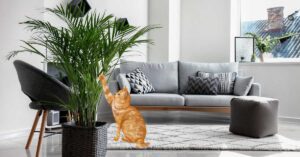
Instructions for use:
- Prefer temperatures between 65°F to 75°F (18°C to 24°C).
- Areca Palms thrive in humid environments. Areca Palms typically need to be repotted every 2-3 years.
- A combination of peat moss, perlite, and sand can create an ideal soil mix for them.
4. Money Tree (Pachira Aquatica)
The Money Tree (Pachira aquatica) is not only a visually appealing indoor plant. Still, it can also be a pet-friendly addition to your home. This tropical plant features vibrant green leaves and a braided trunk, giving it a unique and decorative appeal.
When it comes to pets like cats and dogs, the Money Tree is considered non-toxic, making it a safe choice to have around your furry friends. Unlike some other houseplants, the Money Tree won’t pose a risk if your pets happen to nibble on its leaves or come into contact with it. However, it’s still essential to monitor your pets’ behaviour around any plants and discourage them from chewing on any household foliage to prevent any potential health issues.
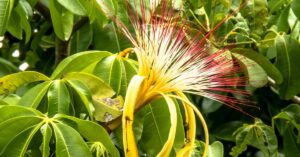
Instructions for use:
- Place in bright, indirect light. Water when the top 1-2 inches of soil is dry.
- Avoid overwatering and provide occasional misting.
- Keep the plant in a warm environment, ideally between 65-75°F (18-24°C).
5. Calathea (Calathea spp.)
Calathea (Calathea spp.) is a stunning and popular houseplant known for its vibrant foliage and unique patterns. While it adds beauty to any indoor space, it’s essential to consider its safety when it comes to our furry friends. The good news is that Calathea plants are generally non-toxic to cats and dogs, making them a pet-friendly choice for plant enthusiasts.
However, it’s still crucial to prevent pets from chewing or ingesting any plant material as it may cause mild gastrointestinal discomfort. As responsible pet owners, it’s always wise to monitor our pets’ interactions with plants and provide suitable alternatives to prevent any potential issues.

Instructions for use:
- Avoid exposing them to direct sunlight.
- It needs a temperature range of 65-80°F (18-27°C).
- Avoid allowing the plant to sit in standing water.
6. Friendship Plant (Pilea Involucrata)
The Friendship Plant, scientifically known as Pilea Involucrata, is a beautiful houseplant known for its vibrant green leaves and unique foliage patterns. While it’s a delight for plant enthusiasts, it’s essential to consider the safety of our furry friends when introducing new plants into our homes. With its pet-friendly nature and aesthetic appeal, the Friendship Plant can be a lovely addition to any pet-friendly household!
Fortunately, the Friendship Plant is generally considered safe for cats and dogs. It is non-toxic and poses no significant threat if ingested. However, it’s always a good idea to monitor your pets around any new plant to ensure they don’t develop any unusual behaviour or digestive issues. Additionally, it’s wise to keep the plant out of reach or use a hanging basket to prevent curious pets from nibbling on the leaves.
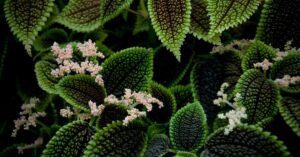

Instructions for use:
- Friendship plants prefer indirect, bright light.
- Maintain a warm temperature between 65-75°F (18-24°C)
- Water your Friendship Plant when the top inch (2.5 cm) of soil feels dry.
7. Bamboo Palm (Chamaedorea seifrizii)
If you are a plant enthusiast and a proud pet owner, finding greenery that is safe for your furry friends can be a top priority. One such plant that fits the bill is the Bamboo Palm (Chamaedorea seifrizii). Not only does it add a touch of tropical elegance to your home, but it is also a pet-friendly choice.
In our bamboo palm care guide, we cannot stress enough how crucial it is to prioritize the safety of your cats and dogs. This resilient houseplant is non-toxic to both cats and dogs, making it an ideal choice for pet-friendly households. By opting for safe potted palms like the Bamboo Palm, you can create a harmonious environment where your beloved pets can roam freely without any worries.
Instructions for use:
- Bamboo palms prefer bright, indirect light. Avoid exposing them to direct sunlight, as it can scorch their leaves.
- They thrive in average room temperatures between 60-75°F (15-24°C).
- They also prefer medium to high humidity levels.
- Water when the top inch of soil feels dry.
8. Watermelon Peperomia
There are several types in the Peperomia family. Still, we prefer the Watermelon (a quick look at its leaves explains how it received its name). They like to be kept out of direct sunlight and don’t require much watering to thrive.
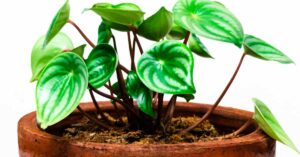

Instructions for use:
- Though it won’t require much water, you should water your peperomia when the top inch or two of the soil is dry to the touch.
- Keep it between 65 and 80 degrees Fahrenheit.
9. Calathea Orbifolia
The Calathea Orbifolia is a stunning houseplant known for its large, round leaves with intricate patterns. While it adds a touch of beauty to any space, it’s important to note that certain varieties of Calathea, including the Orbifolia.
If you have furry friends at home, it’s crucial to keep this plant out of their reach to ensure their safety. Although it may be disappointing to limit the accessibility of this captivating plant, the health and well-being of our beloved pets always come first.
This trendy plant is not harmful to dogs and cats; instead, it improves their environment due to its air-purifying qualities and striking big leaves. For any pet parents out there – this houseplant is non-toxic & very friendly.



Instructions for use:
- To care for your Calathea Orbifolia, place it in bright, indirect light and keep the soil consistently moist but not soggy.
- Maintain a temperature between 65-80°F (18-27°C) and a humidity level of 50% or higher. Avoid direct sunlight and cold drafts.
- Fertilize every 2-4 weeks during the growing season.
10. Ponytail Palm
Choosing the proper houseplants for your living space may be difficult, and locating pet-friendly plants is much more difficult.
While dogs enjoy lazing around the house, cat owners are well aware that they are rather curious. With a rambunctious puppy who wants to explore every nook and cranny, it’s critical not to have any hazardous plants in the house.
Ponytail palms, with their cascading leaves and bulbous caudex, are trendy houseplants. Elephant’s Foot Tree and Bottle Palm are two other frequent names. They make excellent houseplants since they are slow-growing, low-maintenance, and can live for decades.


Instructions for use:
- Place it in bright, indirect sunlight.
- Water sparingly, allowing soil to dry between waterings.
- Use well-draining soil and avoid overwatering to prevent root rot.
- Maintain a room temperature of 65-85°F (18-29°C).
- Fertilize every 2-3 months during the growing season.
11. Succulents
One of the challenges of having pets and plants is creating a safe environment for both. Fortunately, most succulents are totally safe for animals to consume. Furthermore, most animals naturally avoid succulents. They just don’t smell or taste very well. It might be challenging to create a safe environment for both dogs and plants. Fortunately, most succulents are entirely safe for animals.
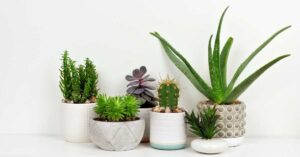

Instructions for use:
- Though you will only have to do a little to care for these popular houseplants.
- Make sure they get enough direct sunlight and light.
- Watering every two weeks.
12. African Violet
These flowers would be an excellent, colourful addition to the open shelf in your kitchen. (Just keep the plant away from draughty floor vents or windows.) They will blossom wonderfully in shady sunshine. It may flower almost all year and thrive indoors if adequately cared for. Cats and dogs are not poisoned by African violets.
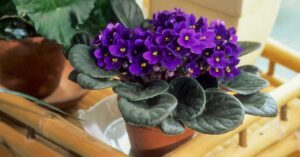

Instructions for use:
- These blooms flourish in temperatures ranging from 73 to 77 degrees Fahrenheit, but adult plants can tolerate temperatures as low as 68 degrees.
- They will require moderate watering (attempt to put water under the leaves). Fertilize them on a regular basis because they can bloom all year.
